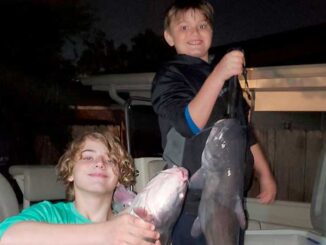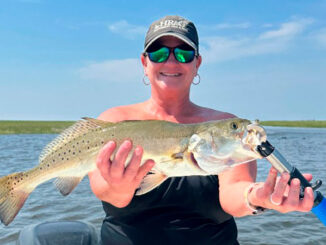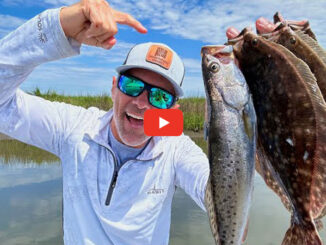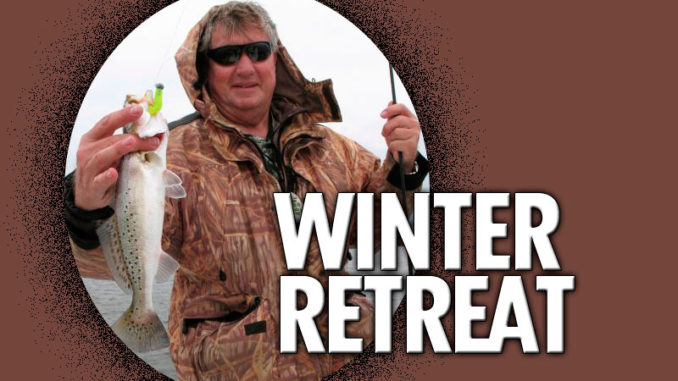
Head to Delacroix’s Oak River this month for boatloads of specks — even if cold weather and high winds make you think about staying home.
Last year the winter action in Oak River was good. In fact, better-than-good.
Capt. Ron “Ahab” Broadus (504-914-6063) said his February calendar from last year records some outstanding redfish catches and some decent speckled trout catches in a month not known for much in the way of productivity.
The majority of his action came from up in the Orange Bayou section around Bay Lori and in Lake Batolal, where he caught fish at the cuts in Oak River and drifting around points in Lake Batola while fishing plastics under a cork.
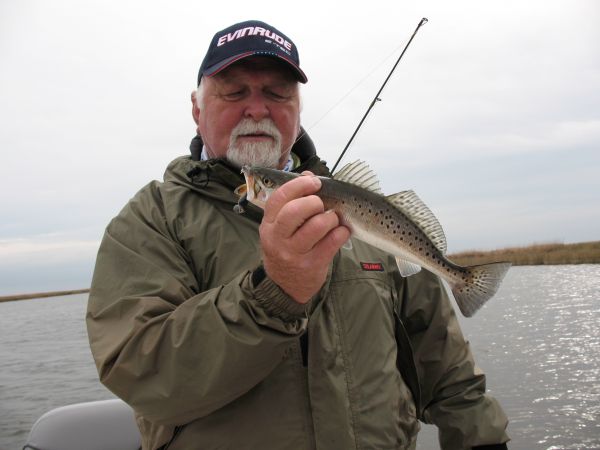
But last winter didn’t bring much in the way of cold down here to the southeastern part of Sportsman’s Paradise — at least not like this winter.
This winter is one for the books. We don’t often hear phrases like “polar vortex,” “arctic express” and “Hercules” in reference to extreme weather conditions. With summer heat waves or tropical storms, yes, but with winter?
Who woulda thunk it?
But so far the extreme weather hasn’t ended the trout bite, at least not everywhere — and one place where the action has been nothing short of phenomenal is Delacroix’s Oak River.
I’d heard several reports of outstanding catches and easy limits coming from that area this winter, and was eager to get over there to see for myself, so when Capt. Mike Wittich (504-577-4774) called, and asked if I wanted to go fishing Oak River with him and Capt. Ahab the next day, and do I want to come along, I said yes without hesitation.
And without consulting the weather forecast.
The forecast was for a cold night and a colder day, a day without sunshine and winds howling between 25 and 30 knots.
“We think we can get out there and catch some fish before the windmill really turns on,” Wittich said on the phone. “It’s our only shot for a while, because the weather goes downhill for a whole week after this.”
That convinced me to put on my long johns and layer up for what would certainly be a bone-chilling boat ride. But you know the old expression: “No pain, no gain.”
Hopes to beat the wind were dashed the moment I stepped out of my truck onto the dock where Ahab and Wittich keep their boats, as the beginnings of the expected “artic express” cold front arrived early.
Undeterred, we hunkered down in the boat (as much as anybody can hunker in a center console bay boat) and made the ride across Little Lake to the Pencil Canal and then south to Oak River.

Ahab said Oak River was producing fish almost anywhere from Orange Bayou to the Twin Pipelines, but he thought the best action was along the stretch between Orange Bayou and the Pencil Canal.
“The boats have been stacked up in here every single day, and everybody is catching fish,” he said. “Some days I’ve counted 20 to 40 boats all up and down Oak River, and it looked like everybody was catching fish.”
Wittich said his advice is to look for a section of Oak River near a cut to one of the bays, and then anchor closer to the south side — close enough so you can almost reach the bank with a long cast. That way you can cast toward the bank and you can also cast toward the deeper middle of Oak River. The fish could be on either side or on both sides.
“You don’t know exactly where the fish will be, but as long as this cold remains I do believe they’ll stay in or near Oak River, but you’ll have to make some casts to locate them,” Wittich said. “I start by casting toward the south shoreline of the river, and I work my bait slow and let it fall down the dropoff, where the depth drops from 2 or 3 feet to 6 to 8 feet.
“That’s where the trout and reds like to hang out — right along that ledge.”
He said he uses either a single jig on a 3/8- or ½-ounce jighead, or double 3/8-ounce jigs tight-lined.
“Give that ledge a thorough working over, and also you want to toss out toward the deeper middle where the water is 14 to 16 feet deep or so,” Wittich said. “When it’s real cold, those fish will sometimes snuggle up right on the bottom and just hold there, hardly moving. But you bounce a bait in front of them and they’ll suck it in.

“When you reel in a trout and see the little leaches all over their belly, you know they were squatting dead on the bottom. So the key is getting all the way to the bottom, so you have to use a heavy-enough jig to get down there, which can be a real challenge when that tide is rolling through. Cast out, give your bait time to sink all the way to the bottom’ then close your bail and get the slack out. You can do a slow-and-steady retrieve back toward the boat, or you can do some small, slow hops with your bait along the bottom, just nothing fast.”
But don’t expect to have trout hammer a bait like during the summer.
“Remember: The bite will be more like a small tap, like maybe your bait bumped the bottom,” Wittich said. “No huge hook set is necessary; just pull your rod up and back and start reeling.
“The action has been so phenomenal the past few weeks that skill levels don’t matter — even an amateur can come out here and fill a box with fish.”
Wittich inched the nose of his 24-foot Skeeter bay boat toward the south bank of Oak River and pressed the “hold” button on his auto-pilot trolling motor, engaging the GPS feature that automatically holds the boat in that spot. The motor will do all the work and you can concentrate on fishing.
The tide was falling hard, so the motor raced at high throttle to hold us there, but hold us it did.
Wittich threw tandem-rigged chartreuse curly tail plastics on 3/8-ounce jigheads, and he cast toward the shoreline, reeled in slowly but steadily and allowed the jigs to dribble down the dropoff.
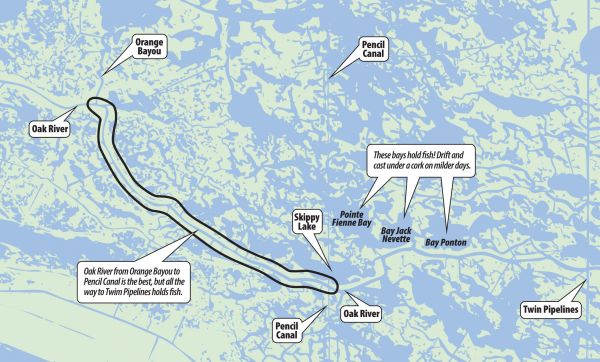 Ahab was casting a single-rigged opening night plastic on a ½-ounce jig out toward the middle of Oak River and allowing time for the bait to reach the bottom before closing the bail and beginning a very slow retrieve.
Ahab was casting a single-rigged opening night plastic on a ½-ounce jig out toward the middle of Oak River and allowing time for the bait to reach the bottom before closing the bail and beginning a very slow retrieve.
I was throwing a single-rigged chartreuse beetle on a 3/8-ounce jig, but it was Wittich who got the first trout — and the second, and the third.
So we all switched to tandem rigs, but the bite we hoped for never really materialized. We’d catch a trout just often enough to make us stay there instead of exploring elsewhere, but after an hour of fishing the trolling motor started losing power and we began drifting off with the current.
“That motor has been running full speed for a whole hour against all that current, and the batteries are wearing down,” Ahab said. “And it’s time to go exploring anyway. We’ve been at this spot too long.”
Wittich agreed, and we picked up and moved down Oak River to a cut into one of the bays where we quickly wrapped the rope of a crab trap around the prop in the shallow water. Fortunately, a good Samaritan boater passing by saw our dilemma, and came over and untangled the rope.
That was all we needed to get back in action.
The good Samaritans were on their way back to the dock with their limits of trout taken by drifting the bays and tossing plastics under corks.
“We caught most of our fish early before the wind started blowing this hard,” one of them said. “And we finished off our limits by just drifting in the back of Skippy Lake, even in all this wind,” the other one said.
“So, Skippy Lake then,” Wittich said, and we were off.
Minutes later we entered the lake to find increasing winds and whitecaps all over the lake. Wittich headed to the back of the lake, killed the outboard and let the winds push us wherever it wanted to.
We all started casting soft plastics under corks, and everybody got hits with almost every cast. In all that wind and those white-capped seas, we still got constant hits.
Our keeper-to-throw-back ratio was probably 1:3, but the fast action under such conditions was astounding.
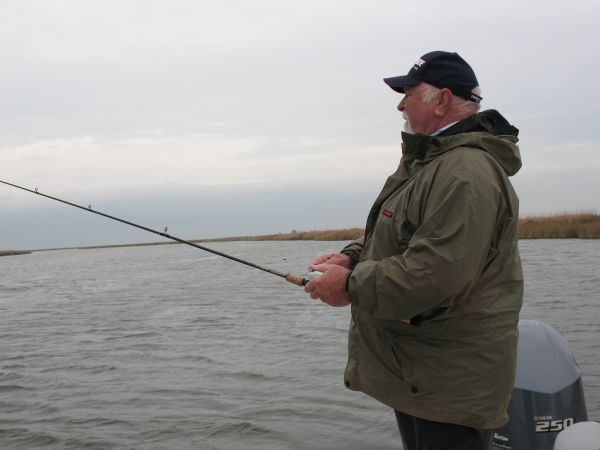
Wittach was using a white Vudu shrimp, and Ahab had on an opening night cocohoe — both under corks. I was tossing a small chartreuse beetle on a 1/8-ounce jig under a popping cork, and I caught a speck on just about every cast.
My chartreuse beetle outfished everything else 2 to 1, and I was catching bigger trout.
The biggest problem was that the winds were howling so fiercely that we drifted across the entire lake in mere minutes, and kept having to go back and redrift. We didn’t redrift in the same exact area.
We tried to stick the Cajun anchor several times, but it wouldn’t hold because of the winds and seas. Wittach dropped the big Danforth anchor over a few times and it held us, but each time we stopped drifting the bite stopped.
And by stopped, I mean it ended. But the minute we resumed our drift, the bite resumed.
“There’s obviously something about the presentation of the bait while drifting that provokes them to strike,” Ahab said. “And these fish are in here so thick right now that you can drift and cast almost anywhere and catch fish. And the rest of the bays are holding a lot of fish, too. Pointe Fienne, Bay Jack, Little Crevasse and along Oak River — all this area is full of fish, both trout and reds.
“Some years it’s like this. Whatever factors converged to make this the winter hotspot, it happened, and the fish are definitely in here.”
Wittach said several factors are at play.
“Water salinity, the (Davis Pond Freshwater) diversion, the air and water temperature, the winds and last year’s lack of hurricanes probably all factor into the equation as to why this stretch of Oak River is so productive this winter,” he said. “Whatever those factors are, they caused the trout and redfish to stack up in here, and I suspect this action will stay steady through February and, depending on the weather, into March.”
However, Wittach cautioned that there are two things that can turn the action off light a light switch.
“One: the diversion,” he said. “An influx of muddy river water will push these fish right out of here in search for better water.
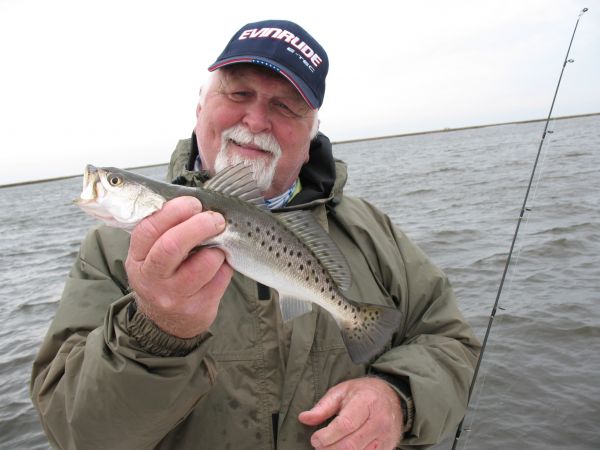
“And two: a dramatic change in the weather. If we have a significant and sustained warm-up, the fish will probably spread out more and move into the shallower water.
“Our fish will go deep in the cold weather, but they don’t stay deep unless they have to. Any warmth at all will draw them up into shallower water where their food supply is and where the sun can reach them.”
Meanwhile, our situation was quickly deteriorating. The almost gale-force winds we were fishing in steadily combined with increasing cold, which made our conditions miserable and, well, crazy.
“You guys have to be nuts to be fishing out here in these conditions,” I shouted over the howling winds as I reeled in another trout for the ice chest.
“You’re right,” Ahab said. “And you’re enjoying it as much as we are.”
“Yep, I replied, “and any time you want to get crazy again, give me a call.”
Editor’s note: Capt. Mike Wittach can be reached at 504-577-4774. Capt. Ron “Ahab” Broadus can be reached at 504-914-6063.
